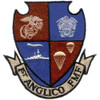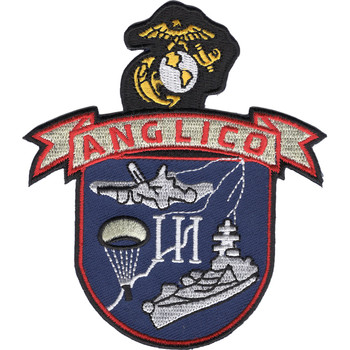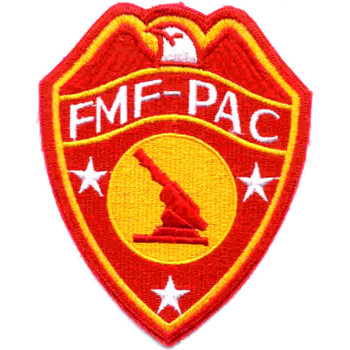Description
1st Anglico FMF Patch (U.S.M.C) 3.5" x 4.0" Embroidered Patch with Iron-On Backing
Superior Materials: Made with premium polyester thread and durable twill fabric, ensuring long-lasting color and strength.
Advanced Embroidery Technology: Crafted using the most advanced embroidery machinery, guaranteeing intricate detail, sharp lines, and consistent quality every time.
Easy Iron-On Application: Features a heat-activated adhesive backing for quick, no-sew attachment. Simply position, iron, and press for a secure bond.
Versatile Use: Perfect for personalizing jackets, backpacks, uniforms, or any fabric surface that needs a touch of personality.
Durable and Washable: Designed to withstand everyday wear and occasional washing without fading or fraying.
Formations & Origins
The 1st Anglico FMF (Fleet Marine Force) Patch represents the 1st Air Naval Gunfire Liaison Company (ANGICO), a specialized unit within the United States Marine Corps. ANGICO was originally formed during World War II in 1943 to provide a crucial link between the U.S. Navy's fire support and Marine Corps ground operations. Their primary role was to serve as forward observers for naval gunfire and air strikes, coordinating and adjusting the fire from naval and air units onto enemy targets with precision. ANGICO units have always been an integral part of the Marine Air-Ground Task Force (MAGTF), which integrates air, ground, and logistical support to create a highly effective, coordinated fighting force.
The 1st ANGICO specifically is one of the oldest and most prestigious units in the Marine Corps dedicated to this mission. It was organized to operate closely with the Fleet Marine Force (FMF), which is a term used to describe the U.S. Marine Corps in its role of supporting the U.S. Navy. ANGICO's legacy is rooted in its ability to call in precise artillery, air, and naval gunfire support from naval vessels and aircraft, ensuring that Marines on the ground have the firepower they need to break enemy lines or take out strategic targets.
Notable Commanders
While the 1st ANGICO has had numerous commanders, the unit's history is intertwined with the leadership of those who shaped its operations in combat zones and during pivotal missions. The unit has often been led by officers with a strong background in artillery, forward observation, and close air support operations. Lieutenant Colonel John W. “Doc” Williams, for example, a commander of the 1st ANGICO during the Vietnam War, was known for his outstanding leadership in coordinating air and naval support that allowed his unit to succeed in several engagements.
In more recent years, ANGICO’s commanders have played key roles in major conflicts such as the Gulf War, Operation Iraqi Freedom, and Operation Enduring Freedom. These commanders ensured that their forward observers worked closely with naval and air forces, coordinating complex strikes and ensuring that the unit could rapidly adapt to changing battlefield conditions.
Major Campaigns/Operations
The 1st ANGICO FMF Patch represents a unit with a rich operational history, having been involved in some of the most intense and important conflicts in modern military history. ANGICO units have been involved in virtually every major U.S. military engagement since World War II, working alongside the U.S. Navy and Marine Corps to deliver precise fire support.
During World War II, ANGICO played a vital role in numerous Pacific island campaigns, including the Battle of Guadalcanal, Iwo Jima, and the Battle of Okinawa. The ability of ANGICO observers to direct naval gunfire and air strikes proved essential in supporting Marines on the ground, particularly in amphibious assaults where enemy positions needed to be neutralized quickly.
During the Korean War, the 1st ANGICO was again called upon to provide essential fire support for Marine and UN forces. Their role was especially important in helping to repel the North Korean and Chinese advances, coordinating naval fire on enemy positions along the coast.
The Vietnam War marked a particularly challenging and dangerous time for ANGICO. In the dense jungles of Southeast Asia, their ability to provide accurate fire support from naval vessels and aircraft became a key to the success of U.S. operations. The 1st ANGICO provided crucial support during operations like Operation Starlite and Operation Rolling Thunder, directing naval gunfire and air strikes to support ground forces in hostile territory.
In the more modern conflicts of the Gulf War, Iraq, and Afghanistan, the 1st ANGICO continued its legacy of supporting combat operations. In the Gulf War, ANGICO was instrumental in directing air strikes during the rapid assault on Iraqi positions. Their coordination with the Navy and Air Force allowed for quick, devastating responses to enemy movements, significantly contributing to the success of the conflict.
Specialized Role/Equipment
The 1st ANGICO FMF Patch represents a highly specialized unit within the Marine Corps, and its role in fire support coordination is critical to its mission. ANGICO’s main responsibility is to call in and adjust naval gunfire, artillery fire, and air strikes, with an emphasis on coordinating with naval ships and aircraft. This requires a deep knowledge of tactical communication, fire support techniques, and the ability to rapidly assess battlefield conditions.
A significant piece of equipment for ANGICO units includes fire support systems like the AN/PRC-117F radio, which allows for secure communication between ANGICO observers and naval ships or aircraft. In addition, ANGICO units often use targeting systems such as the Laser Rangefinder or Target Acquisition Radar to pinpoint enemy positions and ensure that fire support is accurate.
Naval gunfire and airstrikes from aircraft like the F/A-18 Hornet or F-16 Fighting Falcon are often called in by ANGICO personnel, who direct the fire in real-time based on the enemy's position and movement. The 1st ANGICO must also be familiar with working in rugged terrain, dense jungles, or urban environments, which requires adaptability and proficiency in land navigation and observation techniques.
Acts of Heroism
The 1st ANGICO FMF Patch is worn by men and women who have demonstrated remarkable courage and heroism during the most difficult and dangerous missions. ANGICO personnel, often at the forefront of combat operations, have shown immense bravery when directing fire support in close combat situations, sometimes under heavy enemy fire.
One heroic act that stands out in ANGICO history occurred during the Vietnam War. In 1965, Corporal William C. Waugh, a forward observer with the 1st ANGICO, was directing naval gunfire during a search-and-destroy mission in South Vietnam when his unit came under heavy attack. Despite being wounded and surrounded by enemy forces, Corporal Waugh continued to direct fire support until he was critically injured. His actions saved countless lives and were later recognized with a Silver Star.
Similarly, in more recent conflicts, ANGICO personnel have put themselves in harm’s way to ensure fire support reaches its targets. Their ability to adapt quickly and operate under extreme pressure has made them a vital part of Marine Corps combat operations, and many have been awarded high honors for their bravery.
Legacy & Notable Achievements
The 1st ANGICO FMF Patch carries with it a legacy of excellence and specialized skill. Over the decades, the unit has earned a reputation for being one of the most capable and professional units in the Marine Corps, with a history of providing essential fire support in some of the most challenging environments in the world. Their ability to coordinate with both the Navy and Air Force to provide precise fire support is a testament to their training, adaptability, and effectiveness.
The unit’s achievements include significant contributions during the Korean War, Vietnam War, Desert Storm, Iraq War, and Operation Enduring Freedom. In every one of these conflicts, the 1st ANGICO played a key role in shaping the success of operations, ensuring that Marines on the ground had the air and naval fire support they needed to achieve their objectives.
Perhaps one of the most notable achievements of 1st ANGICO was its pivotal role during the Battle of Khe Sanh in 1968 during the Vietnam War. The ANGICO unit was instrumental in directing naval gunfire that helped to break the siege of the Khe Sanh Combat Base, providing essential support to the Marines who were surrounded by North Vietnamese forces.
The 1st ANGICO FMF Patch also symbolizes the enduring legacy of cross-service cooperation, particularly between the U.S. Navy, Marine Corps, and U.S. Air Force. ANGICO personnel are at the forefront of ensuring that this coordination remains seamless, regardless of the conflict, ensuring that fire support is accurate, timely, and devastatingly effective. This collaboration continues to be one of the cornerstones of modern Marine Corps operations, making 1st ANGICO one of the most respected and essential units in the service.


















